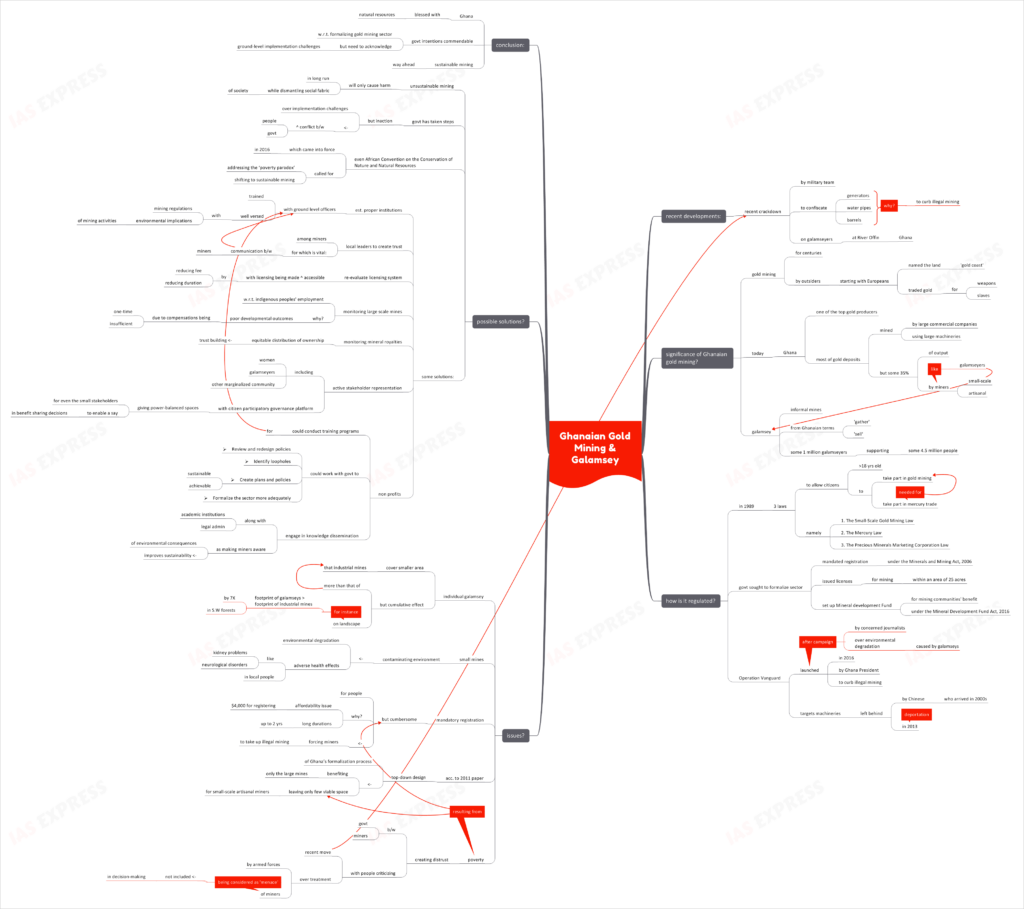Ghanaian Gold Mining & Galamsey

Recently, a military team confiscated generators, water pipes and barrels from ‘galamseyers’ at Ghana’s River Offin. This was an operation to curb illegal mining.

This topic of “Ghanaian Gold Mining & Galamsey” is important from the perspective of the UPSC IAS Examination, which falls under General Studies Portion.
How significant is gold mining sector in Ghana?
- Ghanaian gold has been mined for centuries, by various outsiders- starting with the Europeans. The Europeans named the land ‘gold coast’. In the past, the gold was traded for weapons, which were in turn traded for slaves.
- Today, Ghana is one of the top gold producers in the world. Majority of the gold deposits are mined using heavy machinery by large commercial companies.
- However, some 35% of Ghana’s gold output is from small-scale artisanal gold miners, like the ‘galamseyers’. These informal mines are called ‘galamsey’- a term derived from Ghanaian words for ‘gather’ and ‘sell’.
- There are some 1 million galamseyers, supporting some 4.5 million people in Ghana.
How does the country regulate the sector?
- In 1989, the Ghanaian government passed 3 laws to allow citizens, above 18 years old, to take part in small-scale gold mining and in mercury trade:
- The Small-Scale Gold Mining Law
- The Mercury Law
- The Precious Minerals Marketing Corporation Law
- Over the years, the government has sought to formalize the sector. For instance, it made it mandatory for all miners to be registered under the Minerals and Mining Act, 2006.
- The government issued licenses to individuals for mining within an area of 25 acres.
- The government had set up the Mineral Development Fund, under the Mineral Development Fund Act, 2016, for the benefit of the mining communities.
- In 2017, the country’s President launched Operation Vanguard to curb illegal gold mining. This followed campaign by concerned journalists over the galamseyer activities leading to environmental degradation.
- In the 2000s, the Chinese entered the picture and brought in heavy machinery. When they were deported in 2013, these machineries were left behind. These mining machineries are the target of the current drive.
What are the issues?
- Individual galamseys cover lesser areas than industrial mines. However, their cumulative effect on the country’s landscape outweighs the effect of industrial-scale mines. For instance, the footprint of small-scale mines is about 7 times more than that of larger mines in the south-western forests.
- These small mines are contaminating the environment- leading to environmental degradation and adverse health effects- like neurological disorders and kidney problems- among the local population.
- Though the government has mandated registration to formalize the sector, there is the issue of affordability. Not many citizens can pay the $4,000 for registering themselves as gold miners.
- The registration process is cumbersome too. It can take up to 2 years in some cases. This is another factor forcing miners to operate illegally.
- According to a 2011 paper, the top-down design of Ghana’s formalization process is benefiting only the larger companies while leaving very few viable spaces for small-scale artisanal miners.
- The resulting poverty is leading to distrust between the government and the likes of the galamseyers.
- The recent crackdown at the River Offin was criticised over the armed forces’ treatment of the galamseyers. These small-scale miners are considered as ‘a menace’ to the society by the Ghanaian government and are mostly excluded from the decision making process.
What are the possible solutions?
- Unsustainable mining has only caused more harm than good in the long run, while also dismantling the society’s social fabric.
- Though the government has taken many steps to address these issues, not taking action to address the implementation challenges would escalate the conflict between the people and the government.
- The African Convention on the Conservation of Nature and Natural Resources, which came into force in 2016, calls for addressing the ‘poverty paradox’ and shifting to sustainable mining.
- For this, these solutions could be considered for adoption:
- Establishment of proper institutions with ground level implementing officers who are properly trained and well-versed with the mining regulations and the environmental implications. Local leaders need to create trust among the miners and the communication between the miners and the officers is vital for this.
- Re-evaluation of the licensing system. Licensing should be made more accessible by reducing the fee and the process duration.
- Monitoring large-scale miners with regards to the employment of indigenous people. Often, poor developmental outcomes in indigenous communities result from their land being taken up by large companies for inadequate one-time compensations.
- Monitoring of mineral royalties. When the ownership of these royalties are distributed in an equitable manner, it will create a sense of ownership among the community members- a vital step in trust-building.
- Active stakeholder representation. Galamseyers, women and other marginalized communities must find representation in decision making. Citizen participatory governance platforms should give power-balanced spaces for even the small stakeholders to have a say in decision on benefit-sharing.
- Non-profits should take part in the process too. They could conduct training programs for ground-level officers and work with the government to
- Review and redesign policies
- Identify loopholes
- Create plans and policies, which are sustainable and achievable
- Formalize the sector more adequately
- They can be aided in knowledge dissemination by academic institutions and the legal administration. Making the miners aware of the environmental consequences could help with improving the sector’s sustainability.
Conclusion:
Ghana has been blessed with rich deposits of natural resources. While the government’s intentions behind formalizing the gold mining sector is commendable, there is a need to acknowledge the ground-level implementation challenges. Sustainable mining is the way ahead.
Practice Question for Mains:
Examine the practice of ‘galamsey’ in Ghana’s gold mining sector and the government’s attempts to weed it out. What are some possible solutions? (250 words)

